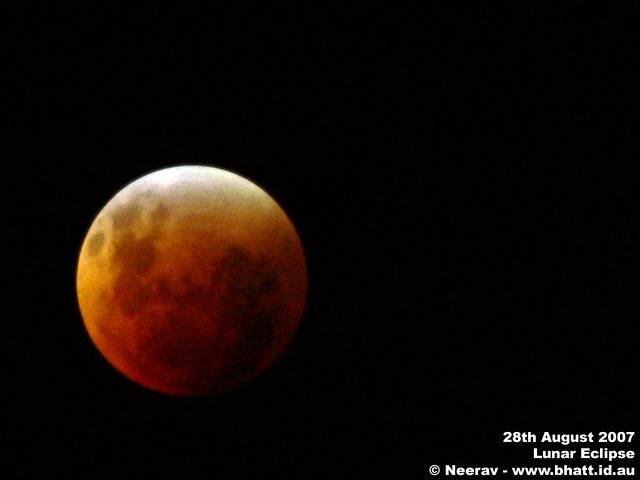Last night there was a full lunar eclipse, where the Earth blocked the Sun’s rays of light from hitting the moon and I like many photographers around the world was awake trying to take photos of it. Many articles on the internet still give advice about how to take Lunar Eclipse photos with a film camera so here are some general tips for more modern digital cameras!
photo credit: Neerav Bhatt – Lunar Eclipse 10/11 December 2011 – Viewed from Sydney Australia (Canon 60D with 70-300mm L lens @ 480mm (35mm equiv)

photo credit: Neerav Bhatt – Lunar Eclipse 28th August 2007 – Viewed from Sydney Australia (Panasonic FZ30 420mm @ 35mm equivalent)

A lunar eclipse occurs when the Moon passes behind the Earth so that the Earth blocks the Sun’s rays from striking the Moon. This can occur only when the Sun, Earth, and Moon are aligned exactly, or very closely so, with the Earth in the middle. Hence, a lunar eclipse can only occur the night of a full moon. This NASA video explains the science in an easy to understand way.
Best Camera Settings & Tips for Great Lunar Eclipse Photos
There are lots of articles out there telling you to use very specific camera settings to take lunar eclipse photos but I think they’re wrong to be so exact because people are using so many different types of cameras/lenses and taking photos from such diverse places around the world with different weather and atmospheric conditions in the sky above them that any single set of camera settings won’t work for everyone.
In general though:
- Use a tripod if possible – though it is possible to take eclipse photos with a handheld camera like my 11 Dec Eclipse photo at top of this page if you have a *very* steady grip and use a high enough ISO setting
- A medium/high end digital SLR with a quality telephoto/zoom lense is a lot more likely to get you an eclipse photo with a visible moon large enough to see details.
- If you don’t have a big zoom lense you can take wide angle photos of the moon as it moves across the sky and becomes more eclipsed, totality (fully covered), then less eclipsed. If you stack these photos together it can look very creative.
- If your camera is set up on a tripod use a remote/cable trigger to take photos as this will keep the camera steady compared to you pressing the photo button with a finger.
More technically:
- Turn off the flash! The moon is far far away. All your flash will do is light up a few metres around you and totally spoil the eclipse photo as well as your night vision ability to see the eclipse with your eyes.
- Using spot focus and spot metering with the camera focused right on the moon will help you get a photo of the moon with detail and colour rather than an overexposed white blob
- Don’t use a fixed shutter speed all night. The apparent brightness of the moon will change a lot depending on how much of it is covered by the Earth’s shadow. Set the shutter manually and experiment or set it to Auto if your camera is good enough.
- Don’t use a long shutter speed like 1 second or more because the moon moves across the sky and a long camera exposure will make the photo look blurred.
- Use +- bracketing if possible and experiment with different ISO settings to see which setting yields good detail and colour at any given moment
- Don’t be afraid to use a higher ISO (make the camera more sensitive to light) if your first few photos are blurry due to shakiness on your part. I took the photo at the top of this page at ISO Speed: 1250 handheld.
- If taking eclipse photos with your camera on a tripod you’ll be able to close down the Aperture (F stop) to whatever the optimal setting aka sweet spot is for your lens eg: F8 whcih will result in a sharper photo with better details. Every lens is different so you will need to experiment to find the sweet spot.
- If hand holding the camera without a tripod it’s going to be very hard for you to take a sharp photo with shutter speed slower than 1/30th second (amateur photographers) or 1/6th second (professional photographers)
Good Examples of Creative Lunar Eclipse Photography
Photos of an eclipse with dark sky or clouds are very good but the best photos have something else in the background like a bridge, building, mountain landscape etc or if you’re really lucky a plane flying across the moon.
 photo credit: a total eclipse of the cold moon by yellow_bird_woodstock, on Flickr
photo credit: a total eclipse of the cold moon by yellow_bird_woodstock, on Flickr
 photo credit: Lunar Eclipse by puzzlescript, on Flickr
photo credit: Lunar Eclipse by puzzlescript, on Flickr
I created a Flickr Group Pool called Lunar Eclipse 10th/11th December 2011 (10-11/12/2011) where I invited creative photographers to add their eclipse photos. EDITED: Unfortunately you cannot view them as a slideshow because that would breach copyright.

Leave a Reply